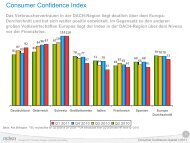You also want an ePaper? Increase the reach of your titles
YUMPU automatically turns print PDFs into web optimized ePapers that Google loves.
Chart 4: Segmenting <strong>Baby</strong> <strong>Boomer</strong> households<br />
without children<br />
Single<br />
<strong>Boomer</strong>s<br />
Single<br />
Person HHs<br />
Trailing Edge<br />
HOH<br />
Age 42–54<br />
Trailing Edge<br />
Couples<br />
Source: ACNielsen Homescan & Spectra<br />
Total <strong>Baby</strong><br />
<strong>Boomer</strong> HHs<br />
without Children<br />
Two<br />
Person HHs<br />
Leading Edge<br />
HOH<br />
Age 55–60<br />
Leading Edge<br />
Couples<br />
Three +<br />
Person HHs<br />
New Family<br />
Frontiers<br />
By contrast, the Ready-to-Launch segment weighs in with<br />
the lowest incidence of Hispanics and the highest incidence<br />
of African-Americans among <strong>Boomer</strong>s. All Ready-to-Launch<br />
households have at least one child over 12, and for the most<br />
part, only children over twelve, skewing toward the late<br />
teens. The Ready-to-Launch segment splits roughly in half<br />
between couples with one child and single parents with one<br />
or two children. Heads of household can be any age within<br />
the <strong>Boomer</strong> bandwidth, and there are few adult children<br />
in view.<br />
Adults only<br />
Apparently Single <strong>Boomer</strong>s hit the books in college, tying<br />
Late Bloomers for the title of “most educated.” Some 41%<br />
of Single <strong>Boomer</strong>s never opted for marriage, and established<br />
single households. Half of the Single segment unpacked<br />
their bags five or more years ago and still call the same<br />
residence home today. ■ See chart 4.<br />
Working<br />
Retirements<br />
Work long and prosper. That’s the new mantra of the <strong>Boomer</strong><br />
generation as it edges toward Social Security eligibility and<br />
retirement age. So hold on to those gold watches, because the<br />
<strong>Boomer</strong>s plan on retiring the traditional concept of retirement<br />
with a characteristically bold move that will surprise detractors<br />
and benefit—rather than hijack—the economic future of the<br />
generations that follow.<br />
The idea is simplicity itself: keep on working, earning and<br />
contributing to the economy for as long as one is able and<br />
enabled. Driven by a host of motivations ranging from selfactualization<br />
to financial need, many <strong>Boomer</strong>s reject the idea of<br />
a leisurely retirement and plan to work well into their 70s and<br />
beyond. In a 2006 Merrill Lynch study, 71% of adults envision<br />
working in retirement, and half of those said they intended to<br />
work as long as they were physically and intellectually able.<br />
Companies need the workers<br />
While the statistics vary dramatically (estimates of a labor shortage<br />
as early as 2010 range from 800,000 workers to almost<br />
10 million), the inescapable fact remains that the “baby bust”<br />
generation numbers 11 million fewer bodies than the <strong>Boomer</strong>s.<br />
Even with productivity gains, process changes, outsourcing<br />
options and immigration inflows, there simply may not be<br />
enough workers to fill available jobs. The obvious solution:<br />
retain the ones you’ve got.<br />
Progressive employers are experimenting with any number of<br />
riffs on the traditional consulting contracts or part-time positions<br />
available to retired employees. Among the more innovative<br />
working retirement ideas:<br />
• capability-specific personnel banks of skilled temporary<br />
workers;<br />
• roadblocking schedules, where retirees rotate between time<br />
on/off the job for a pre-determined time increment (e.g.,<br />
three months on/off);<br />
• job sharing, reviving what <strong>Boomer</strong> women elevated to an art<br />
form; two individuals sharing a job, salary and performance<br />
expectations;<br />
8 Fall/Winter 2006











